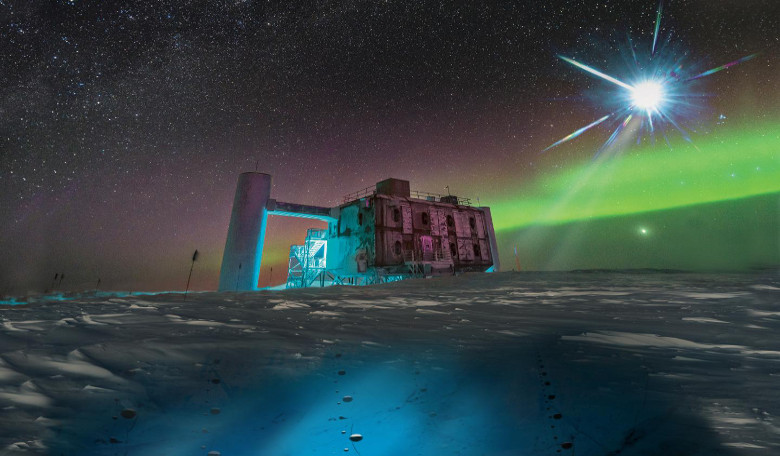A tiny, high-energy particle with very little mass is setting the astronomical world alight, as the captured ‘ghost’ particle is helping scientists to resolve a century-old riddle about what object sends particles such as these whizzing through the Universe at nearly the speed of light.
This sub-atomic particle is a neutrino and their existence is not so much of a mystery (anymore), but where they come from is, as neutrinos are found everywhere. Not only do they permeate space all around us, but every second tens of thousands of neutrinos pass through your body. The reason you are blissfully unaware of this constant bombardment is because neutrinos have no electric charge and virtually no mass; properties that have earned it the nickname ‘ghost’ particle and are befitting with the name bestowed upon it, as neutrino literally means "little neutral one.”
With such little to go on, observing neutrinos is hard work and it takes huge underground bases or isolated laboratories placed at the ends of the world to learn more about these elusive particles.
Projects such as ARRIANNA and the IceCube Neutrino Observatory at the Amundsen-Scott South Pole Station are currently on the look-out for neutrinos and it is the latter that has pinned down the location of a steam of neutrinos pouring out from a blazer; a powerful, energetic jet at the heart of an active galactic nucleus surrounding a supermassive black hole.
Blazers are particularly bright by astronomical standards because the jet is directed towards (or nearly towards) Earth.
Singling out a particular blazer known as TXS 0506+056 as a potential source of neutrinos, IceCube directed its corroborators, NASA's orbiting Fermi Gamma-ray Space Telescope and the Major Atmospheric Gamma Imaging Cherenkov Telescope, or MAGIC, in the Canary Islands, to the blazers coordinates, after a single very high-energy neutrino was caught colliding with an atomic nucleus in the Antarctic ice.
After adjusting their sights, the two observatories also picked up a flare of high-energy gamma rays at the same location, indicating very convincingly that TXS 0506+056 was the most likely source.
"This result really highlights the importance of taking a multimessenger approach to these searches," said Erik Blaufuss, a research scientist in the UMD Department of Physics who led the effort over the past several years to create and deploy IceCube's high-energy event alert system. "Any one observation made alone would likely not have let us piece together what is actually going on inside this source."
So why all of the fuss over a minuscule, barely-there particle that doesn’t want to be found? Although neutrinos are created in supernova explosions and in the cores of stars like our Sun, the greatest source of neutrinos happened some 15 billion years ago, when they were created 10-4 seconds after the Big Bang.
At a mere one second after the big bang, the Universe became transparent to the neutrinos allowing them to travel freely through space. By studying these ancient ‘ghost’ particles, scientists can therefore infer what was going on in the Universe just as it started to form. Neutrinos may even may hold the key as to why normal matter won the battle with antimatter so early after the Big Bang. This is to do with how the antineutrino in less inclined to change 'flavour' (from a muon to an electron flavour) compared with its neutrino counterpart
Not only that, but as neutrinos travel practically unhindered through the vastness of space (unlike other particles, neutrinos only interact via the weak nuclear force) they have the potential to map the sky like astronomers currently do with light at differing wavelengths, but at higher energies.
Combining neutrino detections with that of other electromagnetic sources helps paint a picture of the whole of the sky, not just snippets here and there. "The era of multimessenger astrophysics is here," says National Science Foundation Director France Córdova. "Each messenger gives us a more complete understanding of the universe, and important new insights into the most powerful objects and events in the sky. Such breakthroughs are only possible through a long-term commitment to fundamental research and investment in superb research facilities."
Just as the recent detection of gravitational waves ushered in a new branch of astronomical research, this discovery could pave the same path for neutrino astronomy, and telescopes all around the world would follow the neutrinos lead to zero in on the same object. However, before that happens the joint neutrino/gamma-ray detection must be thoroughly scrutinised to be nothing short of infallible.
With a roughly one in 740 probability that the neutrino just happened to coincidentally come from the blazer location I.e it looked like it came from the blazer, but really it came from elsewhere, the link between the two isn't yet guaranteed. Astronomers generally want better odds than this before making game-changing claims relating to their research.











